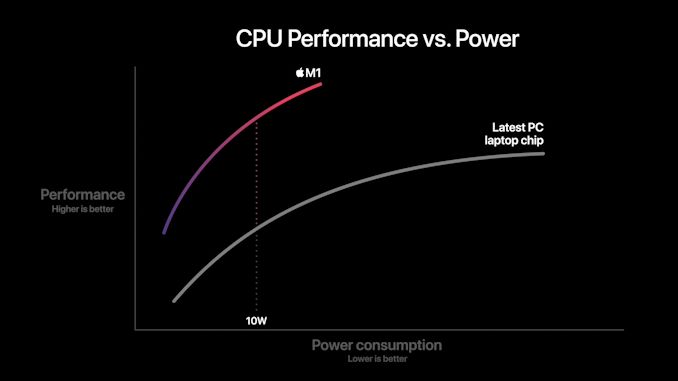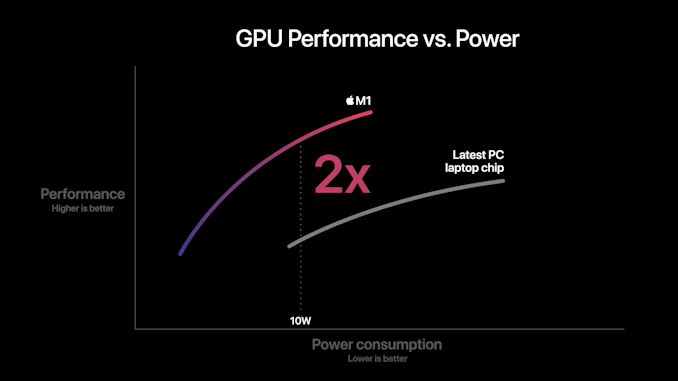Apple Announces The Apple Silicon M1: Ditching x86 - What to Expect, Based on A14
by Andrei Frumusanu on November 10, 2020 3:00 PM EST- Posted in
- Apple
- Apple A14
- Apple Silicon
- Apple M1
Apple Shooting for the Stars: x86 Incumbents Beware
The previous pages were written ahead of Apple officially announcing the new M1 chip. We already saw the A14 performing outstandingly and outperforming the best that Intel has to offer. The new M1 should perform notably above that.
We come back to a few of Apple’s slides during the presentations as to what to expect in terms of performance and efficiency. Particularly the performance/power curves are the most detail that Apple is sharing at this moment in time:
In this graphic, Apple showcases the new M1 chip featuring a CPU power consumption peak of around 18W. The competing PC laptop chip here is peaking at the 35-40W range so certainly these are not single-threaded performance figures, but rather whole-chip multi-threaded performance. We don’t know if this is comparing M1 to an AMD Renoir chip or an Intel ICL or TGL chip, but in both cases the same general verdict applies:
Apple’s usage of a significantly more advanced microarchitecture that offers significant IPC, enabling high performance at low core clocks, allows for significant power efficiency gains versus the incumbent x86 players. The graphic shows that at peak-to-peak, M1 offers around a 40% performance uplift compared to the existing competitive offering, all whilst doing it at 40% of the power consumption.
Apple’s comparison of random performance points is to be criticised, however the 10W measurement point where Apple claims 2.5x the performance does make some sense, as this is the nominal TDP of the chips used in the Intel-based MacBook Air. Again, it’s thanks to the power efficiency characteristics that Apple has been able to achieve in the mobile space that the M1 is promised to showcase such large gains – it certainly matches our A14 data.
Don't forget about the GPU
Today we mostly covered the CPU side of things as that’s where the unprecedented industry shift is happening. However, we shouldn’t forget about the GPU, as the new M1 represents Apple’s first-time introduction of their custom designs into the Mac space.
Apple’s performance and power efficiency claims here are really lacking context as we have no idea what their comparison point is. I won’t try to theorise here as there’s just too many variables at play, and we don’t know enough details.
What we do know is that in the mobile space, Apple is absolutely leading the pack in terms of performance and power efficiency. The last time we tested the A12Z the design was more than able to compete and beat integrated graphics designs. But since then we’ve seen more significant jumps from both AMD and Intel.
Performance Leadership?
Apple claims the M1 to be the fastest CPU in the world. Given our data on the A14, beating all of Intel’s designs, and just falling short of AMD’s newest Zen3 chips – a higher clocked Firestorm above 3GHz, the 50% larger L2 cache, and an unleashed TDP, we can certainly believe Apple and the M1 to be able to achieve that claim.
This moment has been brewing for years now, and the new Apple Silicon is both shocking, but also very much expected. In the coming weeks we’ll be trying to get our hands on the new hardware and verify Apple’s claims.
Intel has stagnated itself out of the market, and has lost a major customer today. AMD has shown lots of progress lately, however it’ll be incredibly hard to catch up to Apple’s power efficiency. If Apple’s performance trajectory continues at this pace, the x86 performance crown might never be regained.












644 Comments
View All Comments
grayson_carr - Wednesday, November 11, 2020 - link
The article explains that a wider CPU design would be much more difficult for x86. You should probably read it.vais - Thursday, November 12, 2020 - link
Wider instruction decoder doesn't always mean better. And remember you are comparing two entirely different instruction sets. As mentioned in the article x86 has variable length instructions, so one instruction can be decoded into multiple micro operations.Anyway, take a look at this quote from the article specifically:
"On the ARM side of things, Samsung’s designs had been 6-wide from the M3 onwards, whilst Arm’s own Cortex cores had been steadily going wider with each generation, currently 4-wide in currently available silicon"
So Samsung's core is 6 wide, while Cortex are 4 wide. Isn't snapdragon using Cortex cores, assuming "only" 4 wide - how the hell it outperforms the "superior" architecture?
Apple's A14 is 30-40% faster than Exynos and Snapdragon (let's say). And how do Exynos and Snapdragon compare to desktop x86 CPUs? They are lightyears behind and this is normal.
rtharston - Thursday, November 12, 2020 - link
Hear hear. Armv8 (ARM64) is a newer, cleaner ISA, with different design decisions, including purposefully breaking compatibility with ARM32 in many ways* (hence why iOS and macOS dropped 32 bit app support a while back), which means Apple has an easier time making some things bigger, because they are simpler than in x86.*Yes, you can run ARM32 bit apps on ARM64 chips, if they've included the necessary support, but it is separate hardware and commands. Apple decided to rip out that extra hardware a few generations of A chips back, freeing up space and complexity for other things. x86 hardware still supports running code meant for the 8086 which released nearly 40 years ago, and that adds a lot of complexity.
misan - Thursday, November 12, 2020 - link
I really don't know what more evidence you need. You have been shown various common CPU algorithms running with comparable performance on Apple's phone chip and AMD/Intel desktop chips. It's literally there in the article you are commenting. If you don't find this evidence convincing, how can you be sure that Zen 3 is a fast CPU? That statements based on exactly the same kind of evidence.vais - Friday, November 13, 2020 - link
@misan - the problem is this "evidence" is circumstantial at best and does not reflect actual performance for a normally running A14 vs a normally running (all cores and at full power) AMD 5950X.It does show the architecture is good, but the claims about a 5W chip somehow slamming in the ground a 105W, 16 core Zen3 CPU are nothing but hilarious. Otherwise Crysis would have long been ported for the magically powerful iPhone...
Spunjji - Thursday, November 12, 2020 - link
@Coldfriction - You seem to be getting confused. Custom silicon does indeed punch above its weight, but none of the "small scale tests" done in this article will take advantage of any of it.SPEC results don't translate readily to application performance, but they do serve as excellent ways to compare CPU architectures; whichever way you slice it this architecture is demonstrably impressive.
Mgradon - Thursday, November 12, 2020 - link
Agree fully - for MacBook Air it might be the right think to do. If the new OS will work well. For MacBook Pro i am not sure, would like to see what it can and what it cannot do.daveedvdv - Thursday, November 12, 2020 - link
> No doubt what they have is efficient. But their claims are out of this world high. If it was simply a matter of making a wider CPU design, AMD or Intel would have done exactly that years ago. If it were simply a matter of making a larger L2 cache, AMD or Intel would have done that years ago.Of course. So that's not what dominates Apple's lead. For example, a significant part of Apple's advantage is power management: PA Semi had critical patents in that area and I believe they're still in effect.
techconc - Wednesday, November 11, 2020 - link
"...there's essentially no way that Apple made a general computing CPU that is faster than Intel or AMD..."That's exactly what they've done. They've also done so with a far more power efficient solution. It's funny how people can deny reality even while seeing the results in articles like this. Take the blinders off and see reality.
Coldfriction - Wednesday, November 11, 2020 - link
What results? The benchmarks here are extremely limited in scope. That's not "generic computing".